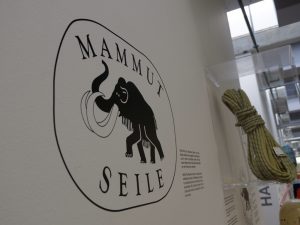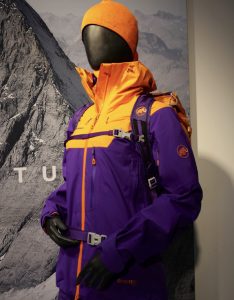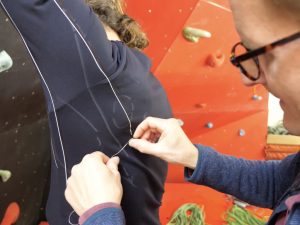At GearLimits we want to know everything about products, but also about brands. The reason for that is that besides informing and advising our audience on gear/products, we also feel it is important for outdoor & actions sporters to know what a brand stands for, what it is all about.
Because products are always the result or an expression of what we like to call, the DNA of a brand. So when we get the opportunity to really talk to the people behind a brand we grab that opportunity: to see who they are, what drives them and why they do what they do: add this all together and the outcome is a product that is the expression of that brand DNA.
A disclaimer before we really get started: We have been able to do this project, with the support of Mammut. As a result, we could travel to Seon, Switzerland, where Mammut’s headquarters are located. At the heart of the company we would talk about the Eiger Extreme collection with the developers of the products themselves. To our question what really was an expression of their DNA, Mammut had put forward the Eiger Extreme collection, a line that started in 1995 and now is in its 4th generation.
1862
 But that DNA is in more than the latest iteration of their most high-end products: it’s also in the company’s origins, how they started. And that goes back to 1862 when Kaspar Tanner made a rope for the first time which was called Mammut because of its strength. In 1943, the brand would adopt the name. For over 100 years since that first rope, real hardware for mountaineering, ropes, climbing harnesses and carabiners were the focus of Mammut. This changed with the first edition of the Eiger collection (among other things). So by looking closer to the Eiger Extreme today, we are in fact, looking into the history of the brand.
But that DNA is in more than the latest iteration of their most high-end products: it’s also in the company’s origins, how they started. And that goes back to 1862 when Kaspar Tanner made a rope for the first time which was called Mammut because of its strength. In 1943, the brand would adopt the name. For over 100 years since that first rope, real hardware for mountaineering, ropes, climbing harnesses and carabiners were the focus of Mammut. This changed with the first edition of the Eiger collection (among other things). So by looking closer to the Eiger Extreme today, we are in fact, looking into the history of the brand.
Ambitious mountaineers
That is the group that the Eiger Extreme Collection is meant for. Climbers who are really performance driven. With the products in the Eiger Extreme collection, Mammut wants to contribute to that performance. By keeping the climber warm, dry and allowing maximum freedom of movement.

The collection is very broad and quite complete, from the flagship Nordwand Pro jacket and pants, through the Eigerjoch midlayer jacket (which we also look at in the video), to sleeping bags, beanies, gloves and alpine climbing shoes. In separate upcoming posts, we will spend more detailed attention to some of these products.
High-reach technology
The creation of the flagship product, the Nordwand Pro HS Jacket, offered a great insight into how a company like Mammut goes about developing product development.
For the hard shell, Mammut has chosen a special approach to ensure maximum mobility while climbing, wthou compromising the pilars of being warm and dry. The challenge was that when climbing you raise your arms to grab the next hard to reach grip, so that you can continue climing. In this movement oftentimes, your jacket will ride up around the waist, leaving your body less isolated there. Which in extreme circumstances can be at least uncomfortable and in the worst case, dangerous. To solve this, Mammut developed their “high-reach” technology, a pattern technology, in which the way the panels of which the acket is made, are cut and sewn together in such away that the bottom of the jacket does not move or ride up when you go for that high reach.

Mammut thought that you had to start with a human in motion. There is a climbing wall in the office on which they placed a climber, in real active climbing positions. The climber wore a tight shirt, where the pattern developers then drew the areas and lines where the muscles gave tension on the fabric. A smart step of course, since a muscle ‘s form and size will change under pressure, and only then will you know where the piece of clothing should or should not give space. The pressure of that muscle causes the deformation of the fabric.
On the basis of the analysis of the body and muscle movements, they drew lines on the fabric that the various panels should follow. What would become the actual seams. From this analog, three dimensional context, they then brought the panels to the cutting table and further into the regular production process.
Another important step was the extensive field tests, with their pro athletes taking the first iterations up onto the mountain, taking the developers and designers along, and then watching what works and does not work. Improving on every iteration to come to the best possible product.
So what does this tell us about the DNA of Mammut? First of all, that they have been working in Alpinism for a very long time. That the knowledge and experience with the most intensive elements of mountaineering are extensive. And that the protection of the moving climber is core to how they develop their products. Turning to an almost old-school analysis of “real” people instead of 3D software modeling) to produce very high-end products.
As part of our Inside-Out project with Mammut, we will soon be giving away two very cool products from the Eiger Extreme collection. So keep an eye on our site and social media for more information.
[/vc_message]
